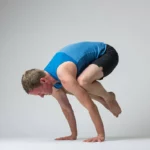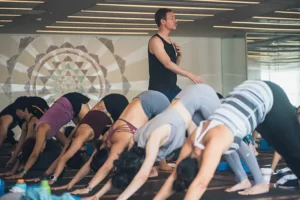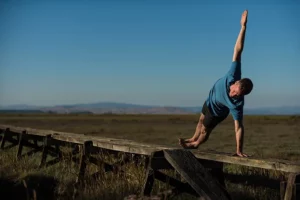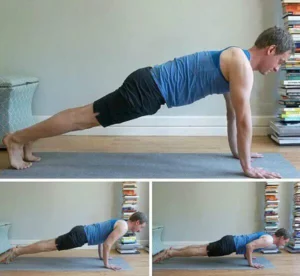WHY THIS EKA PADA KOUNDINYASANA SEQUENCE WORKS
When I practice difficult postures I have to be strategic. Since I don’t have the natural flexibility or raw strength to will myself into advanced postures like Eka Pada Koundinyasana, I have to emphasize preparation, efficient leverage, and technique. For me, this means breaking down difficult postures into small, accessible components.
EKA PADA KOUNDINYASANA QUESTIONS AND ANSWERS
I typically ask myself three questions when I look at a demanding posture like Eka Pada Koundinyasana I:
1. What are the legs and hips doing in the pose?
2. What are the core and spine doing in the pose?
3. What are the shoulders and arms doing in the pose?
It’s a simple, straightforward process that helps me — and can help you — take a complex pose and boil it down into manageable parts. One benefit of this process is that it provides you with aspects of every posture that you can work on even if you can’t do a particular pose in its’ entirety.
When I apply these questions to Eka Pada Koundinyasana I, I get simple, straightforward answers. The hips, legs, spine, and core are in Parivrrta Trikonasana The shoulders and arms are in Chaturanga. In other words, Eka Pada Koundinyasana I, is Revolved Triangle Pose on top of Chaturanga. So, this sequence focuses on preparing for a deep Revolved Triangle Pose and a strong Chaturanga.
Let’s break it down a little further:
POSES 1-4
The first three postures will wake up your core. More specifically, the 2nd and 3rd postures in the sequence will fire-up your obliques since they include a demanding twist. These postures set the tone for the sequence by providing you with a preview of the postures and actions that will follow. The 4th posture, Downward Facing Dog, gives you a smooth transition from the reclined postures to the hip-opening lunges.
POSES 5-6
Admittedly, the hamstrings and adductors—which are focused on in pose #5—are not huge components of Eka Pada Koundinyasana. But, those of you with tight hamstrings will benefit from the inclusion of lizard pose, since it will prepare you for Revolved Triangle and Revolved Half Moon. Practicing Pigeon Pose will prepare you for the upcoming twists by creating more mobility in your outer hips and IT bands.
POSES 7-11
Poses 7 through 10 give you a straightforward progression of standing twists. Each twist builds on the previous twist as the progression slowly increases in demand. These postures prepare your outer hips, IT bands, and spine for the demands of Eka Pada Koundinyasana. The 11th pose, Revolved Utkatasana, provides you with a standing twist that closely resembles the next posture in the sequence—Side Crow, or Parsva Bakasana.
POSES 12-13
Parsva Bakasana is the foundation for all arm balances that include a twist. When you develop the strength, flexibility and overall coordination to do this pose proficiently, you’re also setting the stage for other twisting variations. Also, Parsva Bakasana is a great pose for transitioning into Eka Pada Koudinyasana.
See also Essential Sequence: Open into Hanumanasana
{illustration by MCKIBILLO}
Want more sequences by Jason?
Sign up to join our newsletter and we’ll send you our e-book:
30 Essential Home Practice Sequences.





